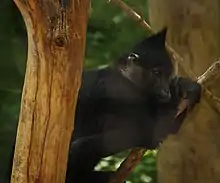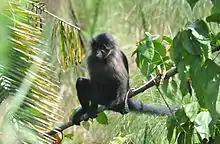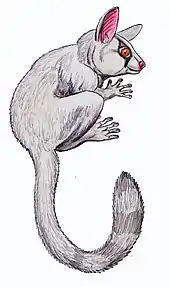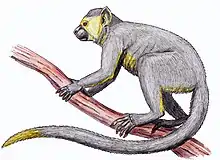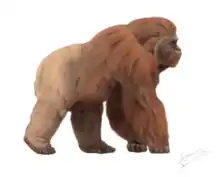| Crested mangabeys[1][2] | |
|---|---|
 | |
| Juvenile Uganda mangabey | |
| Scientific classification | |
| Domain: | Eukaryota |
| Kingdom: | Animalia |
| Phylum: | Chordata |
| Class: | Mammalia |
| Order: | Primates |
| Suborder: | Haplorhini |
| Infraorder: | Simiiformes |
| Family: | Cercopithecidae |
| Subfamily: | Cercopithecinae |
| Tribe: | Papionini |
| Genus: | Lophocebus Palmer, 1903 |
| Type species | |
| Presbytis albigena Gray, 1850 | |
| Species | |
|
See text | |
The crested mangabeys are West African Old World monkeys belonging to the genus Lophocebus. They tend to have dark skin, eyelids that match their facial skin, and crests of hair on their heads. Another genus of mangabeys, Cercocebus, was once thought to be very closely related, so much so that all the species were placed in one genus. However, Lophocebus species are now understood to be more closely related to the baboons in genus Papio, while the Cercocebus species are more closely related to the mandrill. In 2006, the highland mangabey was moved from Lophocebus to a new genus, Rungwecebus.
Species
There are two species in this genus, with a total of six subspecies. In 2007, Colin Groves described a new subspecies and elevated the L. albigena subspecies to full species level, but the elevation was not widely accepted.[3][2][4]
| Common name | Scientific name and subspecies | Range | Size and ecology | IUCN status and estimated population |
|---|---|---|---|---|
| Black crested mangabey
|
L. aterrimus (Oudemans, 1890) Two subspecies
|
Central Africa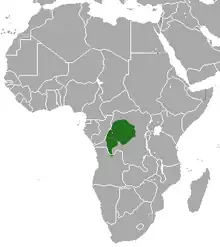 |
Size: 45–65 cm (18–26 in) long, plus 80–85 cm (31–33 in) tail[5] Habitat: Forest[6] Diet: Fruit[5] |
VU
|
| Grey-cheeked mangabey
|
L. albigena (Gray, 1850) Four subspecies
|
Central Africa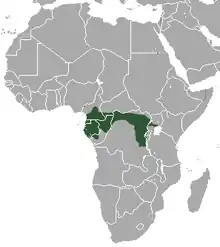 |
Size: 44–75 cm (17–30 in) long, plus 57–94 cm (22–37 in) tail[7] Habitat: Forest[3] Diet: Fruit and seeds[3] |
VU
|
References
- ↑ Groves, C. P. (2005). Wilson, D. E.; Reeder, D. M. (eds.). Mammal Species of the World: A Taxonomic and Geographic Reference (3rd ed.). Baltimore: Johns Hopkins University Press. pp. 160–161. ISBN 0-801-88221-4. OCLC 62265494.
- 1 2 "New monkey species in Mabira - expert". 2007-02-16. Archived from the original on 2007-02-19. Retrieved 2007-02-17.
- 1 2 3 4 Maisels, F.; Hart, J.; Olupot, W.; Oates, J. F. (2020) [amended version of 2019 assessment]. "Lophocebus albigena". IUCN Red List of Threatened Species. 2020: e.T12309A166607033. doi:10.2305/IUCN.UK.2020-1.RLTS.T12309A166607033.en.
- ↑ Groves, Colin (2007). "The Endemic Uganda Mangabey, Lophocebus ugandae, and Other Members of the albigena-Group (Lophocebus)" (PDF). Primate Conservation. 22. Archived from the original (PDF) on 2008-07-27.
- 1 2 Kingdon 2015, p. 126
- 1 2 Maisels, F.; Hart, J.; Laudisoit, A. (2020) [amended version of 2019 assessment]. "Lophocebus aterrimus". IUCN Red List of Threatened Species. 2020: e.T12310A166607638. doi:10.2305/IUCN.UK.2020-1.RLTS.T12310A166607638.en.
- ↑ Kingdon 2015, p. 125
Sources
- Kingdon, Jonathan (2015). The Kingdon Field Guide to African Mammals (Second ed.). Bloomsbury Publishing. ISBN 978-1-4729-2531-2.
